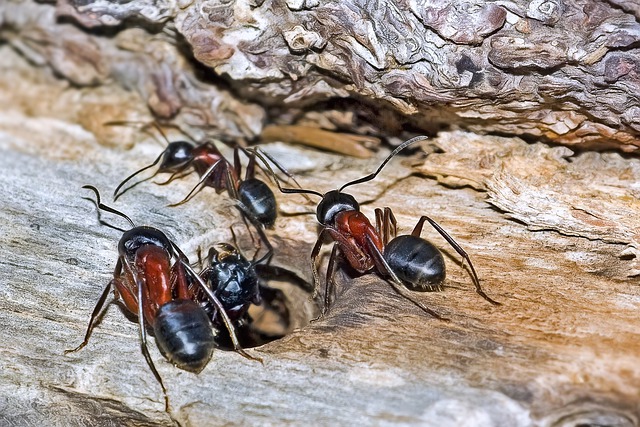Great Falls, Virginia -
Maryland and Virginia pest control company Backyard Bug Patrol has published a blog post on its website that discusses carpenter ants, the damage they can cause to the home, and how to deal with them. The article can be read in its entirety by heading over to the link: https://backyardbugpatrol.com/pest-control/pests-cause-damage-in-your-home/.
There are a lot of insect species in nature that feed on wood and plant matter. When they are introduced to civilization or if their habitat happens to overlap with that of humans, they continue their feeding habits that most people consider a nuisance. Property owners often complain of insects burrowing in their homes and doing extensive damage to the wooden base materials of the structure. Some of the pests mentioned in the blog post from Backyard Bug Patrol that have an affinity for wood include carpenter bees, powder post beetles, and carpenter ants. The blog post discusses the former two briefly and then dives into talking about carpenter ants at length.

Carpenter bees usually bore circular tunnels about the size of a nickel in untreated wood. If such holes are found on the exterior of the house, it is a fairly certain sign that the damage is most likely being caused by carpenter bees. If the holes instead are tiny and numerous, they could be the work of smaller wood-destroying insects such as carpenter ants or powder post beetles. One way to determine which of the latter two is causing the damage is to examine the kind of wood that is being attacked. Powder post beetles prefer hardwood and often attack furniture as well as hardwood building materials whereas carpenter ants are more likely to target softwood, especially softwood that is rotting or has been water damaged. Readers who want to find out more about how Backyard Bug Patrol can remedy their wood-destroying pest problem can read more about the company’s Great Falls, Virginia operations by heading over to its Yelp page at https://www.yelp.com/biz/backyard-bug-patrol-great-falls-2.
The blog post then talks more about carpenter ants, their natural habitat, nesting preferences, social structures, and eating habits. They are named so due to their tendency to make little nests in wooden structures or crafted objects. Carpenter ants seek out moist locations to nest, frequently in decaying wood-like dead tree limbs, stumps, tree holes, or landscape timbers. Carpenter ants in homes are most likely from satellite colonies. A parent colony can be as far away as the length of a football field, or even further. Typically, they will be found in moist areas around windows and doorways, as well as bathrooms, kitchens, pipes, drains, and roof vents. Crawl spaces or attics that are consistently damp or have water leaks may also attract carpenter ants. Like other ant species, carpenter ants will eat virtually anything, including other insects, so it can be easy for them to wander into the home while they’re foraging for food. They like protein, fats, and sugars, and any number of kitchen spills, from pet food to sugary substances, can draw them inside.
The blog post then talks about conditions in the home that make for ripe breeding and nesting grounds for carpenter ants. The blog post advises homeowners that if they have the particular set of conditions as described in their home they can expect to be inundated with a carpenter ant infestation. If the door and window frames in the property are often wet due to leakages or bad weather, they can make an excellent destination for carpenter ants who will carve hollow tunnels through these pieces of wood, compromising their integrity. If not addressed, the pests can weaken the frames and make them easy to break. The same applies to the home’s drywall. Walls and attics insulated with fiberglass and other foam insulation may create a perfect shelter for carpenter ants. However, if the walls have cellulose insulations, their outer layer is usually coated with repellant chemicals that will ward off the pests.
Readers can message Backyard Bug Patrol for inquiries and find out contact information by following it on its Facebook page at https://www.facebook.com/BackyardBugPatrol.
Ensuring that children don't get Lyme Disease in their own backyard. We provide outdoor pest control services in northern Virginia to prevent mosquitoes, ticks, stink bugs, and ants.
Backyard Bug Patrol
Great Falls, VA 22066
November 27, 2023 – Backyard Bug Patrol Thanks Customers for Successful Tick and Mosquito Season
October 27, 2023 – Backyard Bug Patrol Is Offering 100% Organic Pest Control Services In Great Falls, Virginia
September 14, 2023 – Backyard Bug Patrol Warns About Alpha Gal Syndrome That Is Caused By Tick Bites
August 22, 2023 – Backyard Bug Patrol Warns that Malaria Has Found Its Way Back into the United States
July 24, 2023 – Backyard Bug Patrol Warns About the Recent Uptick in the West Nile Virus Disease
June 15, 2023 – Great Falls’ Backyard Bug Patrol Offers A Comprehensive Anti-Mosquito Barrier To Keep Mosquitos At Bay All Summer Long
June 01, 2023 – Backyard Bug Patrol Receives Multiple 5-Star Reviews for Services and Work Ethic
May 19, 2023 – Virginia Based Pest Control Company Backyard Bug Patrol Celebrates New 5 Star Reviews
April 19, 2023 – Backyard Bug Patrol Drives Away Mosquitoes & Ticks During Spring
April 04, 2023 – Backyard Bug Patrol: "Do Mosquitoes Really Have Preferences?"